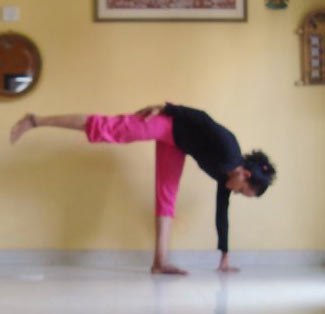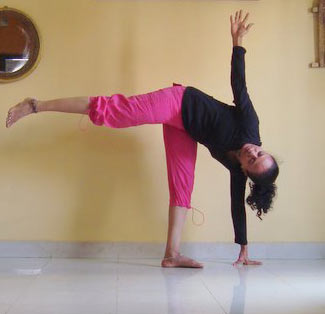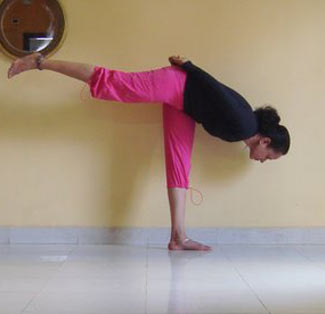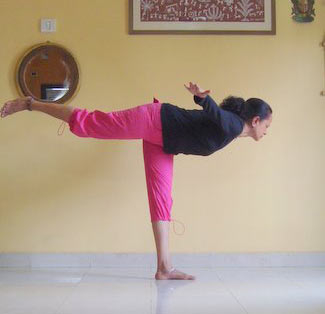Photographs: Jahnavi Sheriff Shameem Akthar
Most people hit a plateau in their yoga practice after they reach a certain level of expertise with a set of poses. As easy as it is to break this phase of lethargy, it is as necessary.
The most important reason to keep challenging yourself in this fashion on the mat is to break the emotional lethargy that occurs from repeating the same poses. Another reason is that the muscles get used to the poses and do not respond to a particular motion. This means though your practice may continue to keep you healthy, its contribution in other areas will be compromised, which means it may not have much effect in your attempts to tone-up or become slimmer. To break this 'muscular boredom', it is important to keep tweaking the poses every few weeks.
Shameem Akthar, yoga acharya trained with the Sivananda Yoga Vedanta Center, takes your through five variations of the ardha chandrasana or crescent pose to show how you can design your own growth in your yoga practice. She also explains why this may be necessary. Here Shameem takes one pose and demonstrates its variations. You can thus source variations for every pose, keeping your yoga practice stimulating.
Catch more of Shameem's yoga writings and information about her upcoming workshops at jaisivananda.blogspot.com.
This article only attempts to enthuse readers towards yoga practice and complement your existing practice. Yoga is best learnt under the personal guidance of a teacher.
Variation 1
Image: Ardha chandrasana (Crescent, variation 1)Stand up straight and bend your right leg at the knee lightly. Draw back your left leg straight behind you. Inhale. Exhaling, bend forward to place both your hands on the ground, on either side of your right foot. Inhale, lift your left leg, keeping it as straight out and behind as possible. Look at the ground in front of you, breathing normally. Hold the pose for as long as is comfortable. Release, repeat and hold the pose for equal duration for your left leg.
Benefits: Improves mental focus. Tones and trims the entire body if held long. Works the spine and is therapeutic for most back problems.
Variation 2
Image: Ardha chandrasana (Crescent, variation 2)Stand up straight. Bend your right leg at the knee lightly. Draw your left leg back. Inhale, exhaling, bend forward to place your right hand beside your right foot. Place your left hand on your left hip. Inhale and lift your left leg in the air, keeping it straight. Continue to maintain your focus on the ground, breathing normally, holding for as long as is comfortable. Release and repeat for equal duration for the other leg.
Benefits: Same as the previous only more enhanced.
Variation 3
Image: Ardha chandrasana (Crescent, variation 3)Stand up straight. Bend your right leg at the knee lightly. Draw back your left leg behind you. Inhale, exhaling bend forward to place your right hand beside your right foot. Lift your left hand in the air. Inhale, lift your left leg keeping it straight. Look at a spot in front of you. If your balance is good, you may up the challenge and look at your hand held up in the air. Hold the pose, breathing normally. Release to repeat for the other side.
Benefits: Same as above, but more enhanced.
Variation 4
Image: Ardha chandrasnaa (Crescent, variation 4)Stand up straight. Bend your right leg at the knee lightly. Draw back your left leg. Inhale, exhaling bend forward. Simultaneously lift both your hands, placing them behind, over your hips or back, as shown. Look straight ahead. Straighten your leg behind you to hold it as straight as possible. Breathe normally throughout. Hold for as long as is comfortable. Release the pose and repeat for the other side.
Benefits: Same as above, but more enhanced.
Variation 5
Image: Ardha chandrasana (Crescent, variation 5)Stand up straight. Bend your right leg at the knee lightly. Draw back your left leg. Inhale, then exhaling bend forward. Simultaneously lift both your hands, placing them along your torso, as shown. Look ahead. Straighten your leg behind to hold it as straight as possible. Breathe normally throughout. Hold the pose for as long as is comfortable. Release, to do the other side.
Benefits: Same as the previous pose, but more enhanced.







Comment
article